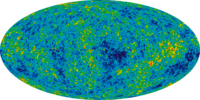
Photo from wikipedia
In this study, we consider nonlinear interactions between components such as dark energy, dark matter, matter and radiation in the framework of the Friedman-Robertson-Walker space-time and propose a simple interaction… Click to show full abstract
In this study, we consider nonlinear interactions between components such as dark energy, dark matter, matter and radiation in the framework of the Friedman-Robertson-Walker space-time and propose a simple interaction model based on the time evolution of the densities of these components. By using this model we show that these interactions can be given by Lotka-Volterra type equations. We numerically solve these coupling equations and show that interaction dynamics between dark energy-dark matter-matter or dark energy-dark matter-matter-radiation has a strange attractor for 0 > wde >−1, wdm ≥ 0, wm ≥ 0 and wr ≥ 0 values. These strange attractors with the positive Lyapunov exponent clearly show that chaotic dynamics appears in the time evolution of the densities. These results provide that the time evolution of the universe is chaotic. The present model may have potential to solve some of the cosmological problems such as the singularity, cosmic coincidence, big crunch, big rip, horizon, oscillation, the emergence of the galaxies, matter distribution and large-scale organization of the universe. The model also connects between dynamics of the competing species in biological systems and dynamics of the time evolution of the universe and offers a new perspective and a new different scenario for the universe evolution.
Journal Title: Scientific Reports
Year Published: 2017
Link to full text (if available)
Share on Social Media: Sign Up to like & get
recommendations!